Mechanical clock keys
Mechanical clock keys is the clock part that is most frequently lost. Once the clock key is no longer with the clock it always seems to end up missing. With the below information you can order a new key utilizing the clock key size chart.
Getting the right one
We have mechanical clock keys in all the sizes available. Between the key chart or by movement type information below, the chances are good of getting the perfect key. The movement type includes if the clock is made in Germany or USA and when it was made.
This is the fastest and most easiest way to get the clock key. The further back in time we go with clocks the more the key chart would need to be used instead. There will be a stamp with the country of origin on the back plate of the movement and this can help us get the key.
Keys for German units post WW2
German made post WW2 movements that are square or rectangle will take a number 8 keys or crank.
If the clock movement is round and made in Germany the key size is number 4. Some round ones will take a number 3 but if getting a 4 it will still fit and wind the clock either way.
Keys for USA units 1900 - 1950
American clocks made from around 1875 until after the second war almost always take the size 7 clock key. The number 7 keys fits the 8 day time / strike units pretty much every time and this is what USA made the most of. This rule may not apply to Westminster (3 places to wind) or time only (one place to wind) clock movements.
Keys for Korean and Chinese clocks
Size 7 for these units usually. All the 31 day clocks with Asian movements and also US replicas made in India, all take size 7.
The over wound myth
Of course any clock that is not working will be wound all the way up from trying to make it run. Everyone winds it up and the clock does not work so the non working clock is always wound up.
The only way a clock can be over wound is if its been wound up for so long that the mainspring stuck.
When the mainspring is stuck together to itself with rust and goo for so long it may stick that way. This is rarely the situation and usually the clock would have rust on it if the mainspring is so wound up it will not wind down.
Double-End Clock-Key F-S Note
The following is a Double-End Clock-Key F-S Note that will be very handy. Some clocks have a small place that looks like a mini clock winding arbor at the 12. It may say F/S or A/R. The F/S represents fast or slow, and the A/R represents advance or retard.
This controls the timing of the clock and turning it to fast or advance makes time faster and the opposite for slow. An ideal double end key fits both the winding arbor to wind the clock and also fits the smaller time regulator aspect.
This is not easy to get and at the same time is the most lost part. It is possible to regulate the clock another way with an adjustable bob instead of a fixed length bob.
Get the double end key the hard way
Using the clock key size chart, get the right size that the clock requires. This chart works for both the fast/slow regulator and also to wind the clock.
However, this is not easy because it requires a measurement of the post the double end key fits onto. In order to get this measurement remove the clock movement or the dial. Without access to the front of the movement it is hard to measure exactly how wide the arbors are that the key is to go on.
Double end clock key the easy way
There are many sizes and combinations for the double end key and it may be tricky to get the right size. Sometimes it is best to just get the 4 pack of double end keys we offer
. These are the top 4 most common double end clock keys so the odds are one will be the correct key. Ideally this will supply the clock with a key that fits both the F/S regulator and the winders. However be aware this 4 pack does not guarantee one will work.
Double-End Clock Key F-S Note Continued - An alternate method
It is possible to forget the whole double end key game and use a single end key instead. It does make things easier and is a better long term solution.
Inevitably, once the perfect fit the key will get lost again. This seems to be the trend of what happens. Once the key is separate from the clock, there is a higher chance of it getting lost. Many times we suggest putting the key in the bottom of the clock case for safe keeping
Using an adjustable bob instead
The solution to the double end key problems is to get the single end key to wind the clock. Also get the adjustable bob. The adjustable bob can be regulate the clock with the pendulum instead.
The bob will have a nut on the bottom. Raise the bob on the pendulum to speed up time. The opposite is true for slowing time down. Once regulating the clock, it will stay this way for the most part. Some timing may or may not need to be done when the temperature changes vastly.
For the most part, time the clock and it will stay that way within a couple of minutes a day all year long. The adjustable pendulum bob comes in three sizes, or bob diameters. The middle or smaller diameter bob is fine for most clocks because the weight is not as important as the length.
Parts available to purchase
Other parts to consider besides the double end clock keys. We have two styles of the adjustable pendulum bobs. One of them is the three sizes of bobs that have the nut underneath. We call this the Adjustable Mantle Clock Bob.
There is another style bob that is adjustable from the back side. We just call it the Adjustable Antique Style Mantle Clock Bob. They both function the same, it has a bob on the pendulum that can regulate the time.
The part they hang onto is usually a long wire with flex spring steel on the top. This gets bent and cut into shape for the proper length. It comes in a three pack and we call them the Long Suspension Spring Rods.
Clock key size chart explanation
Clock keys have there own number system from 000 to 16 as seen in the Clock key size chart. However the number does not indicate what size is what number and can be confusing. So how do you use the Clock key size chart to get the right key?
It would make more sense if the key size was the MM of how wide the key was to fit, but this is not how it works. This section is to figure out what key number to order so the clock can be wound up. Subsequently, the clock key gets lost the most out of any other clock part.
Of course, it can be tricky to find the right key for your clock because there are many sizes. The Clock key size chart will give us the right size key to order.
Double end clock keys
In addition, some keys have two sizes on one key and this is called a double end key. By and large, the clock key size chart will work for both the wind up part of the clock and also the smaller F / S portion. When the clock has a F / S regulator portion it will be at the 12 o'clock on the dial.
Alternately, if there is a small arbor inside of a hole at 12, this is the time regulator control and the key would have two ends. Thus, it may say F / S at this location or A / R. F / S stands for Fast or Slow, or it could say A / R to stand for Advance or Retard and is referring to the timing of the clock.
Of course, if the clock is running fast in time, turn more to the Slow or Retard direction to slow it down. Refer to the Clock key size chart with your measurements to find a key to work with this function.
Getting the right Clock key size
Given these points, to get the key needed, measure the shaft the key is to go on to, then use the Clock key size chart to get the key size needed.
Please do not call asking what key the clock needs, as you will be told it would still have to be measured. In short, measure the shaft that the key goes onto in MM and then use the clock key size chart to match it up.
The lazy way instead of the Clock key size chart
The Clock key size chart has all of the sizes listed however sometimes certain key sizes are known. Generally speaking, almost all post 1960 mechanical clocks, made in Germany take a size #8 key or crank, unless the movement is round.
Ordinarily the round ones take a number 4. The American time strike antique units mostly take the size 7 key. Match your measurements to the Clock key size chart to be sure.
- 1.75mm = 000 Key
- 2.0mm = 00 Key
- 2.25mm = 0 Key
- 2.5mm = 1 Key
- 2.75mm = 2 Key
- 3.0mm = 3 Key
- 3.25mm = 4 Key
- 3.5mm = 5 Key
- 3.75mm = 6 Key
- 4.0mm = 7 Key
- 4.25mm = 8 Key
- 4.5mm = 9 Key
- 4.75mm = 10 Key
- 5.00mm = 11 Key
- 5.25mm = 12 Key
- 5.5mm = 13 Key
- 5.75mm = 14 Key
- 6.0mm = 15 Key
Grandfather Clock Key Crank
A grandfather clock key is also known as a crank. Available in 8 sizes however if the clock is post WW2 the size is always a number 8. A number 8 crank will fit all three weight cable driven post WW2 clocks with a German made movement.
The Crank is made of brass and has wooden handle with no stain on it. The idea is to stain the handle to whatever color best matches the clock case.

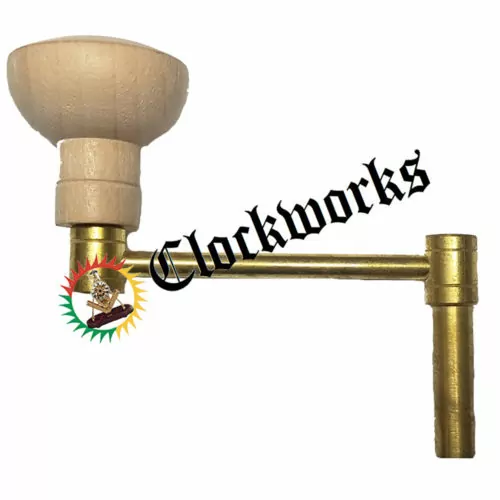


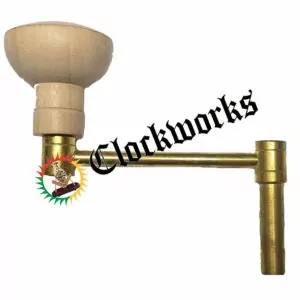
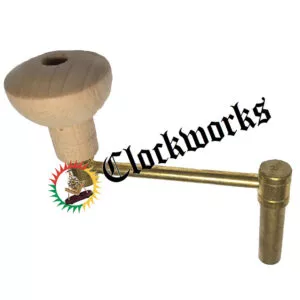
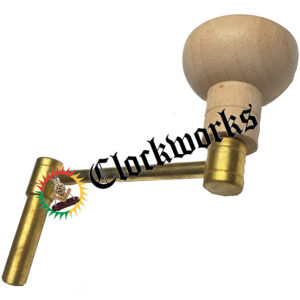

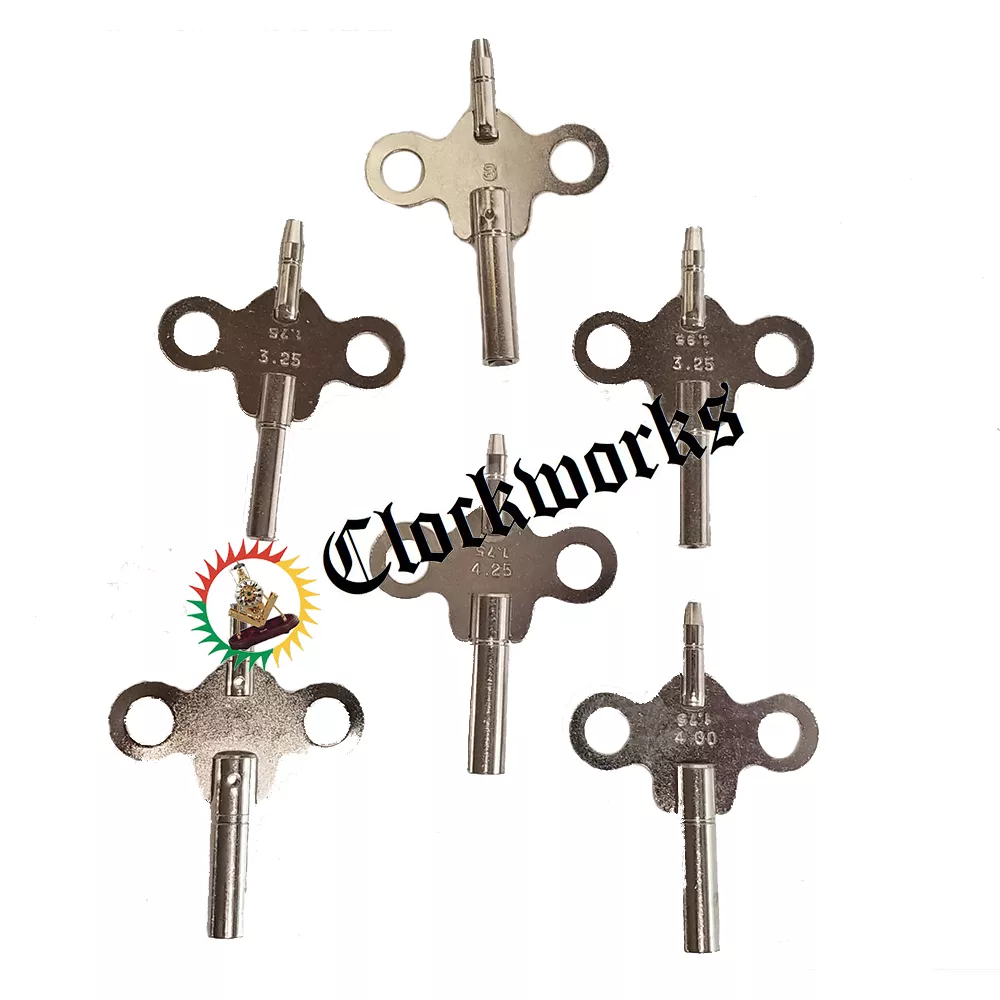
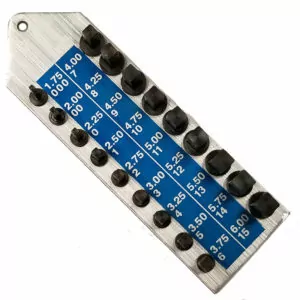
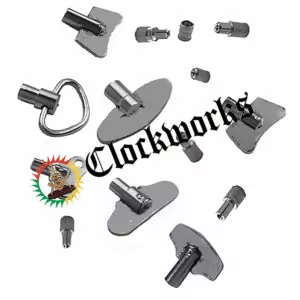











About a 1982 Grandfather clock Ridgeway Tempus Fugit chime getting stuck on silent by itself. I manually move the silent arm from behind & the gear and it starts going again for about 24 hrs. keeps working just stops chiming on it’s own.
Sounds like the chime cam is getting bound up from lack of lube. Upon moving the silent lever it bumps this lever and kicks into the mode it was trying to do in the past, temporarily freeing it from its resistance status.
If the clock was made in 1982, its lived its life, time for the new one. Those are 30 year units at absolute best. Yours is 41 years believe it or not.
What are the numbers off of the back plate of the clock movement itself? If it is hard to get to, usually you can stick a cell phone up behind the movement and get a picture of the numbers. Or through the side access panel if there is one.
James Stoudenmire
30yr Clockmaker
Author of Clockworks.com
Perfect!
My german grandfathers clock is circa 1925 what size key would I need. Mine got lost in a move
That could be any size, best to measure and use the key chart at this link
https://www.clockworks.com/posts/clock-key-size-chart-to-get-the-right-key
then order from here
https://www.clockworks.com/product/grandfather-clock-key-crank
James
My clock is circa 1863 ?? Had a square opening on key
trash
Virus-free.
http://www.avg.com
I have a Tiffany & Co. Grandfather Clock, late 19th Century for which I have lost or misplaced the Clock Key Crank. Any suggestions about how to understand from the chart what size replacement key I look for?
Thank you.
Shaft width / Key #
– 1.75mm = 000 Key – 2.0mm = 00 Key – 2.25mm = 0 Key – 2.5mm = 1 Key – 2.75mm = 2 Key
Shaft width / Key #
– 3.0mm = 3 Key – 3.25mm = *4 Key* – 3.5mm = 5 Key – 3.75mm = 6 Key
Shaft width / Key #
– 4.0mm = 7 Key – 4.25mm = *8 Key* – 4.5mm = 9 Key – 4.75mm = 10 Key – 5.00mm = 11 Key
Shaft width / Key #
– 5.25mm = 12 Key – 5.5mm = 13 Key – 5.75mm = 14 Key – 6.0mm = 15 Key
How am I measuring the shaft? Across the flats or point-point? Makes quite a difference. My English GF clock (circa 1840s) has winding shafts measuring 2.86mm flat to flat. Your chart indicates a #0…
Flat to flat, see this chart
https://www.clockworks.com/posts/clock-key-size-chart-to-get-the-right-key
James
Mechanical clock keys
Mechanical clock keys is the clock part that is most frequently lost. Once the clock key is separated from the clock it always seems to end up missing. With the below information and the clock key size chart a key can be ordered.
Getting the right one
We have mechanical clock keys in all the sizes available. Between the key chart or by movement type information below, the chances are good of getting the perfect key. The movement type includes if the clock is made in Germany or USA and when it was made. This is the fastest and most easiest way to get the clock key. The further back in time we go with clocks the more the key chart would need to be used instead. The country of origin would be marked on the back plate of the movement and this can help us get the key.
Keys for German units post WW2
Germany post WW2 movements that are square or rectangle will take a number 8 key or crank. If the clock movement is made in Germany and it’s round the key size is number 4. Some round ones are supposed to take a number 3 but if you get 4 it will still fit and wind the clock either way.
Keys for USA units 1900 – 1950
American clocks made from around 1875 until after the second war almost always take the size 7 clock key. The number 7 keys fits the 8 day time / strike units pretty much every time and this is what USA made the most of.
This rule may not apply to Westminster (3 places to wind) or time only (one place to wind) clock movements.
Keys for Korean and Chinese clocks
Size 7 for these units usually. All the 31 day clocks with Asian movements and also US replicas made in India, all take size 7.
The over wound myth
Of course any clock that is not working will be wound all the way up from trying to make it run. Everyone winds it up and the clock does not work so the non working clock is always wound up. The only way a clock can be over wound is if its been wound up for so long that the mainspring stuck. When the mainspring is stuck together to itself with rust and goo for so long it may stick that way. This is rarely the situation and usually the clock would have rust on it if the mainspring is so wound up it will not wind down.
Clock key size chart explanation
Clock keys have there own number system from 000 to 16. However the number does not indicate what size is what number and can be confusing. It would make more sense if the key size was the MM of how wide the key was to fit, but this is not how it works. This section is to figure out what key number to order so the clock can be wound up. The clock key gets lost the most out of any other clock part. It can be tricky to find the right key for your clock because there are many sizes. The chart will give us the right size key to order.
Double end clock keys
Some keys require two sizes on one key and this is called a double end key . The below clock key size chart will work for both the wind up part of the clock and also the smaller F / S portion. You can tell if your clock has a F / S regulator portion by just looking at the 12 o’clock on your dial. If there is a small arbor inside of a hole at 12, this is the time regulator control and the key would have two ends. It may say F / S at this location or A / R. F / S stands for Fast or Slow, or it could say A / R to stand for Advance or Retard and is referring to the timing of the clock. So if the clock is running fast in time, you would need to turn more to the Slow or Retard direction to slow it down.
Getting the right key
To get the key you need, measure the shaft the key is to go on to, then use this chart to get the key size # you need. Please do not call asking what key your clock needs, as you will be told it would still have to be measured. Again, you are measuring the shaft that the key goes onto in MM and then using the below clock key size chart.
The lazy way
Almost all post 1960 mechanical clocks, made in Germany take a size #8 key or crank , unless the movement is round. The round ones take a number 4 usually. The American time strike antique units mostly take the size